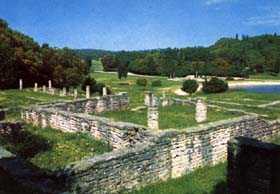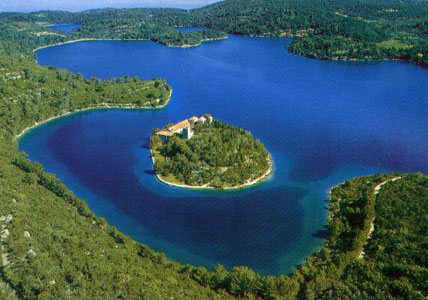
|
 |
Croatian
National Parks, Nature Parks & Reserves


|
|
Croatian
National Parks, Nature Parks & Reserves - A Touch of the Untouched
Beauty
For a country with relatively
small land surface, even in terms of European proportions, Croatia is a
country with great number of National Parks and Natural Reserves. Side
by side in Croatia there are phenomena which are usually many miles apart.
Within a hundred kilometers you will find the sea, the karst, densely wooded
mountains and fertile plains. Ecologically, Croatia has one of the best
preserved environments, with as many as 8 National Parks, 10
Nature Parks and 2 Strict Reserves. |

|
| Croatian
National Parks: |
 World
Heritage National Park Plitvice - The most beautiful and the best
known of all Croatian National Parks, the National Park Plitvice Lakes
is one of the most beautiful natural values in Europe and a part of the
UNESCO World Heritage. Located near the main route that links Croatian
capital city Zagreb with Dalmatia, in a valley between high forested mountains
lie, one below another, sixteen beautiful lakes of crystal blue-green colour.
The lakes themselves cover about 2 square kilometers and are connected
by 92 waterfalls. Over the millennia, the waters of these lakes have dissolved
the limestone rock and carved out the valley in which they now lie. Most
of the area of the Park is covered by dense beech, fir, spruce (some of
them more than 50 meters in height), and pine forests. Various animals
live in the Park, brown bear and wolf among them; many of them are the
species whose numbers are dwindling in the wild. World
Heritage National Park Plitvice - The most beautiful and the best
known of all Croatian National Parks, the National Park Plitvice Lakes
is one of the most beautiful natural values in Europe and a part of the
UNESCO World Heritage. Located near the main route that links Croatian
capital city Zagreb with Dalmatia, in a valley between high forested mountains
lie, one below another, sixteen beautiful lakes of crystal blue-green colour.
The lakes themselves cover about 2 square kilometers and are connected
by 92 waterfalls. Over the millennia, the waters of these lakes have dissolved
the limestone rock and carved out the valley in which they now lie. Most
of the area of the Park is covered by dense beech, fir, spruce (some of
them more than 50 meters in height), and pine forests. Various animals
live in the Park, brown bear and wolf among them; many of them are the
species whose numbers are dwindling in the wild. |

|
 National
Park Brijuni -
The Brijuni islands stretch along the south-west coast of the Istrian peninsula;
they are separated from the Istrian mainland by the Fazana Channel which
is 3 kilometers wide. The archipelago of two large and twelve smaller islands
off Pula make up the National Park Brijuni, which covers an area of 36
square kilometers, including the surrounding sea. National Park Brijuni
abounds in rare animal and plant species, and contains some extraordinary
examples of Roman and Byzantine heritage. There is also a zoo with animals
from other climates. National
Park Brijuni -
The Brijuni islands stretch along the south-west coast of the Istrian peninsula;
they are separated from the Istrian mainland by the Fazana Channel which
is 3 kilometers wide. The archipelago of two large and twelve smaller islands
off Pula make up the National Park Brijuni, which covers an area of 36
square kilometers, including the surrounding sea. National Park Brijuni
abounds in rare animal and plant species, and contains some extraordinary
examples of Roman and Byzantine heritage. There is also a zoo with animals
from other climates. |

|
 National
Park Kornati -
The Kornati islands are the largest archipelago in the Mediterranean (101)
and most of these islands form the National Park. The Kornati National
Park occupies the area of about 220 km2 (54.000 acres). There are 89 islands,
islets and reefs within the area of Kornati National Park (185 km of the
coastline), what makes it also the most indented group of islands
in the Mediterranean. The isles are particularly attractive for sailing-boat
owners, and there are two marinas. National
Park Kornati -
The Kornati islands are the largest archipelago in the Mediterranean (101)
and most of these islands form the National Park. The Kornati National
Park occupies the area of about 220 km2 (54.000 acres). There are 89 islands,
islets and reefs within the area of Kornati National Park (185 km of the
coastline), what makes it also the most indented group of islands
in the Mediterranean. The isles are particularly attractive for sailing-boat
owners, and there are two marinas.
"On the last day of the
Creation God desired to crown His work, and thus created Kornati Islands
out of tears, stars and breath." (George Bernard Shaw) |

|
 NP
Island of Mljet - Situated between the Island Korcula and Dubrovnik,
Mljet is an elongated island, with an average width of 3 km, 37 km long.
It is an Island of great diversity and contrast, and "Mljet" National Park
covers his northwestern part with an area of 5.375 ha of protected land
and surrounding sea. This area was proclaimed as national park 11 November
1960 and represents the first institutionalized attempt to protect an original
ecosystem in the Adriatic. The world-renowned Lakes of Mljet consist of
the Great Lake, covering an area of 145 ha, with a maximum depth of 46
m. The Small Lake has an area of 24 ha and a maximum depth of 29 m. The
natural secrets of both lakes have attracted many scientists over the years,
as well as other nature lovers from a wide range of professions and personal
interests. NP
Island of Mljet - Situated between the Island Korcula and Dubrovnik,
Mljet is an elongated island, with an average width of 3 km, 37 km long.
It is an Island of great diversity and contrast, and "Mljet" National Park
covers his northwestern part with an area of 5.375 ha of protected land
and surrounding sea. This area was proclaimed as national park 11 November
1960 and represents the first institutionalized attempt to protect an original
ecosystem in the Adriatic. The world-renowned Lakes of Mljet consist of
the Great Lake, covering an area of 145 ha, with a maximum depth of 46
m. The Small Lake has an area of 24 ha and a maximum depth of 29 m. The
natural secrets of both lakes have attracted many scientists over the years,
as well as other nature lovers from a wide range of professions and personal
interests. |

|

|
 NP
KRKA - The National Park of Krka covers more than 142 square kilometers
and covers the course of the Krka river between Knin and Skradin. On account
of its hydrological and geomorphological features, Krka is the most amazing
among the rivers of the Croatian karst region. For about two-thirds of
its 72 kilometers long course, the river runs through deep canyons cut
into limestone plateaus. Much of the river is actually a string of elongated
lakes - natural reservoirs created upstream of every one of the many waterfalls.
Between the two most beautiful waterfalls, Skradinski Buk and the Roski
Slap, on the small island Visovac in the middle of the lake there is a
Franciscan Monastery with a valuable library. NP
KRKA - The National Park of Krka covers more than 142 square kilometers
and covers the course of the Krka river between Knin and Skradin. On account
of its hydrological and geomorphological features, Krka is the most amazing
among the rivers of the Croatian karst region. For about two-thirds of
its 72 kilometers long course, the river runs through deep canyons cut
into limestone plateaus. Much of the river is actually a string of elongated
lakes - natural reservoirs created upstream of every one of the many waterfalls.
Between the two most beautiful waterfalls, Skradinski Buk and the Roski
Slap, on the small island Visovac in the middle of the lake there is a
Franciscan Monastery with a valuable library. |

|
 The
Paklenica National Park - NP Paklenica lies on the southern slopes
of the largest mountain range in Croatia, the Velebit. With its surface
area of 96 square kilometers, from the eastern coast of the Adriatic Sea
to the highest peaks of the Velebit Mountains, Vaganski Vrh (1757 m) and
Sveto Brdo (1753 m), Paklenica abounds with numerous natural wonders and
phenomena, which is why the entire area was proclaimed a national park
in 1949. And rightfully so, as this region is simple and unusual in its
connection between the sea and the mountains, rich in beech and black pine
forests, its deep canyons cut vertically into the Velebit ridge, its karst
formations and numerous caves and pits. Paklenica is noted for its
fauna: endemic insects, reptiles and a number of birds, among them the
griffon vulture. The
Paklenica National Park - NP Paklenica lies on the southern slopes
of the largest mountain range in Croatia, the Velebit. With its surface
area of 96 square kilometers, from the eastern coast of the Adriatic Sea
to the highest peaks of the Velebit Mountains, Vaganski Vrh (1757 m) and
Sveto Brdo (1753 m), Paklenica abounds with numerous natural wonders and
phenomena, which is why the entire area was proclaimed a national park
in 1949. And rightfully so, as this region is simple and unusual in its
connection between the sea and the mountains, rich in beech and black pine
forests, its deep canyons cut vertically into the Velebit ridge, its karst
formations and numerous caves and pits. Paklenica is noted for its
fauna: endemic insects, reptiles and a number of birds, among them the
griffon vulture. |

|
 National
Park Risnjak - Risnjak is a forested mountain massif 1528 m high,
situated in the Gorski Kotar region, the most densely wooded part of Croatia
to the north of Rijeka. It includes the area of the Kupa river headwaters.
Due to its location between the Alps and the Dinara mountain and the effects
of both the coastal and continental climates, this relatively small area
(about 30 square kilometers) is a habitat for various species of flora
and fauna, including brown bear, lynx, chamois, deer and short-toed snake
eagle. The beauty and variety of forests, karst formations and monumental
vistas are attracting numerous hikers. National
Park Risnjak - Risnjak is a forested mountain massif 1528 m high,
situated in the Gorski Kotar region, the most densely wooded part of Croatia
to the north of Rijeka. It includes the area of the Kupa river headwaters.
Due to its location between the Alps and the Dinara mountain and the effects
of both the coastal and continental climates, this relatively small area
(about 30 square kilometers) is a habitat for various species of flora
and fauna, including brown bear, lynx, chamois, deer and short-toed snake
eagle. The beauty and variety of forests, karst formations and monumental
vistas are attracting numerous hikers. |

|
 The
Northern Velebit National Park - The youngest Croatian National
Park (designated June1999) is the most valuable and most attractive part
of the summit part of mountain Velebit in terms of nature. The area was
designated a national park due to its richness of carst phenomena, outstanding
biodiversity and exquisitly beautiful nature on a relatively small area.
The Park covers the surface of about 109 km2, and inside there is the Hajducki
& Rozanski Ledges Strict Reserve, famous for its geomorphological phenomena
- the pits. The
Northern Velebit National Park - The youngest Croatian National
Park (designated June1999) is the most valuable and most attractive part
of the summit part of mountain Velebit in terms of nature. The area was
designated a national park due to its richness of carst phenomena, outstanding
biodiversity and exquisitly beautiful nature on a relatively small area.
The Park covers the surface of about 109 km2, and inside there is the Hajducki
& Rozanski Ledges Strict Reserve, famous for its geomorphological phenomena
- the pits. |

|
|
|

|
 |

If
you are frustrated by slow, costly, ineffective advertising methods that
used to work, welcome to what works now!
Attract
new clients with special promotions and features on the Net!
|
 |








